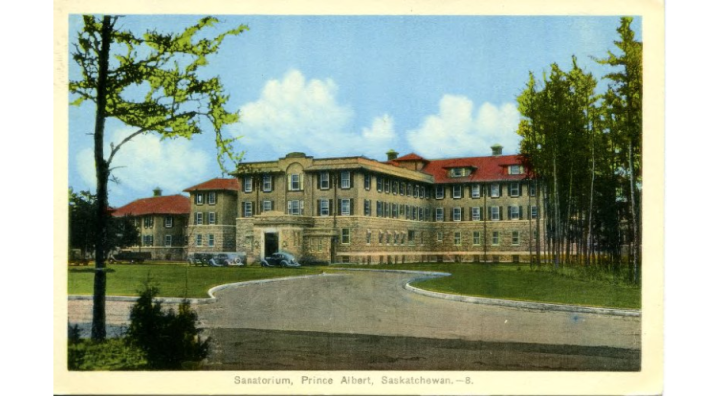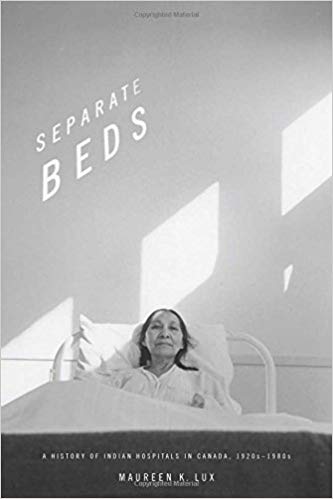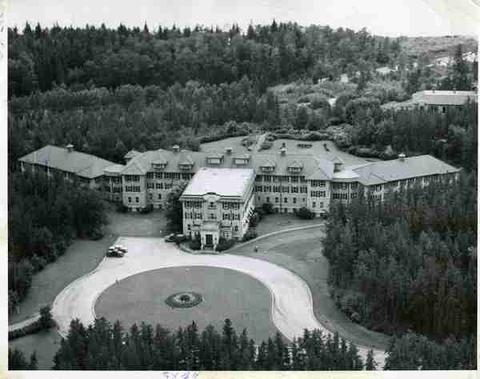Originally published in the Prince Albert Daily Herald on November 2, 2017

Saskatchewan’s third and largest sanatorium for the treatment of tuberculosis was officially opened on the north side of the river in Prince Albert on January 6, 1930. Five years later, in October 1936, the Prince Albert Daily Herald reported that 7,591 people had been treated or examined at the local institution in an effort to combat the spread of the disease.
Tuberculosis is a contagious infection that usually attacks the lungs. During the early 1900s, tuberculosis, or “consumption” as it was then called, was a leading cause of death in North America. In Saskatchewan, TB was epidemic among Indigenous peoples, and was the most common cause of death in non-Indigenous adults between the ages of 20 and 25. Spread by impure milk, drinking cups, and breathing in germs in overcrowded homes, the “white plague” destroyed many families before it came under control in the 1950s.
Like most of the sanatoria that were established in Canada during the late nineteenth and early twentieth centuries, the Prince Albert institution was designed to look like a European spa. Built among the pines near what is now Little Red Park, the three-story, chalet-like main building could originally accommodate 225 patients. Over the years, its capacity grew; it had 270 to 280 patients daily by the early 1950s.
The Prince Albert sanatorium offered “open air” treatment, bed rest, and nourishing foods to its patients. Very few people could afford to pay to stay at a sanatorium for months at a time. Therefore, in 1929, the Government of Saskatchewan passed a bill to provide free treatment for people suffering from tuberculosis. Saskatchewan was the first place in North America to provide free treatment for the disease – an important stepping stone towards Medicare.
While the province’s three sanatoria at Fort Qu’Appelle, Saskatoon, and Prince Albert received public funding, the Saskatchewan’s Anti-Tuberculosis League provided significant financial support for the fight against the disease. Fundraising was also done by the Associated Canadian Travellers (ACT). This group sponsored “Amateur Hour” radio shows, raising $813,000 between 1934 and 1955 to combat tuberculosis in Saskatchewan.
Dr. Robert W. Kirkby was superintendent of the “San” from the time it opened until it closed in 1961. Dr. Kirkby had a staff of 150, including four doctors. There was a school in the sanatorium, accommodating children from grades one to twelve. There was also a crafts instructor for adult patients. In addition to treating sick patients, the sanatorium conducted preventative work in the community, carrying on clinics and mass X-ray surveys for TB throughout the province.
 Death rates from tuberculosis were ten times higher among Saskatchewan’s Indigenous people than among non-Indigenous residents. Despite that fact, historian Maureen Lux writes that Aboriginal people “were not generally accepted for treatment” in the province’s three sanatoria. She explains in her book, Separate Beds (2016), that the publicly funded provincial institutions provided free treatment for “taxpayers” only. If beds were available, the Department of Indian Affairs might be permitted to purchase space for treatment. The Prince Albert Sanatorium admitted its first two Indigenous patients in 1935 – five years after it opened. An average of 44 Indigenous patients were admitted during the 1940s, and by the early 1950s, an average of 120 Indigenous patients had beds at the Prince Albert institution. Lux asserts that these increases in Aboriginal admissions reflected the declining need for sanatorium beds by the non-Indigenous people. In 1953, the superintendent of nurses observed in that the PA San was filled with capacity with 270 to 280 patients daily, “a little less than one quarter of these being white people, which is further proof that we are winning our battle against tuberculosis among the whites.” The other three quarters were Aboriginal.
Death rates from tuberculosis were ten times higher among Saskatchewan’s Indigenous people than among non-Indigenous residents. Despite that fact, historian Maureen Lux writes that Aboriginal people “were not generally accepted for treatment” in the province’s three sanatoria. She explains in her book, Separate Beds (2016), that the publicly funded provincial institutions provided free treatment for “taxpayers” only. If beds were available, the Department of Indian Affairs might be permitted to purchase space for treatment. The Prince Albert Sanatorium admitted its first two Indigenous patients in 1935 – five years after it opened. An average of 44 Indigenous patients were admitted during the 1940s, and by the early 1950s, an average of 120 Indigenous patients had beds at the Prince Albert institution. Lux asserts that these increases in Aboriginal admissions reflected the declining need for sanatorium beds by the non-Indigenous people. In 1953, the superintendent of nurses observed in that the PA San was filled with capacity with 270 to 280 patients daily, “a little less than one quarter of these being white people, which is further proof that we are winning our battle against tuberculosis among the whites.” The other three quarters were Aboriginal.
The Prince Albert Sanatorium was closed in May 1961 over the objections of the people of the city. Many could not understand why the Ministry of Health and the Saskatchewan Anti-Tuberculosis League would choose to close the PA San over its two sister institutions when it was the most suitable location for treating northern residents. Nevertheless, the decision was made to transfer the Prince Albert patients – the majority of whom were Indigenous people from northern Saskatchewan – to the sanatorium at Fort Qu’Appelle, making it even more difficult for their family members to visit them.

The sanatorium building was reused as North Park Centre, the Saskatchewan Training School for the mentally handicapped, from July 1961 until it was closed permanently on February 28, 1988. The building was torn down in 1990, although the powerhouse was left standing and was used as a performing arts theatre for a few years. It has since been razed as well.
Today, February 18, 2019, I found stories that my late dad, Murray McKenzie, shared with me. I wrote them down. One included the 2 years that he spent at this same sanitorium fighting for his life with TB. While everyone in his wing perished, thank God, my dad pulled through. Looking at this building adds another dimension onto my dad’s story. I will research this place and doctors more. We are an Aboriginal family.
LikeLike
Thanks for reading and commenting, Gayle. I’m glad you were able to find more information about your late father’s story. One good resource is Maureen Lux’s book, Separate Beds: A History of Indian Hospitals in Canada, 1920s-1980s (2016). All the best, Joan.
LikeLike
I am excited to read the The History of the PA Sanitorium. Thank you Joan My father -in -law Alphonse Beauchesne was Hospitalized there I am guessing between 1940. to1943.They would fleetingly mention the fact he was hospitalized. What channels do I need to ask to find out the years he was a patient?
LikeLike
I’m sorry, Marguerite, but I honestly don’t know. Perhaps you could start by contacting the Provincial Archives of Saskatchewan in Regina:
Telephone (306) 787-4068
Fax (306) 787-1197
Email info.regina@archives.gov.sk.ca
URL http://saskarchives.com
Good luck with your search.
LikeLike
My late sister was placed in TB hospital in mid 30s and she never came home as I was told by my elder sister who is 91 that our sister had pass away at the Prince Albert in 30s. I like to know where she was buried and like to visit her rest place and who where can I found out where the graves are for who never made it home to be buried at thier home villages. Thank you.
Flora Smigel Morin
Sandy Bay SK.
1306 754 3042
LikeLike
I am so sorry for the loss of your sister. I’m afraid I don’t know the answer to your question about where grave sites are located. Perhaps you could ask the Prince Albert Historical Society. They have an archives which you can email. Here’s the address: archives@historypa.com
LikeLike
Disgusting article. Racist pieces of garbage.
LikeLike